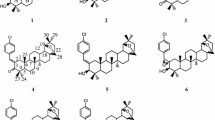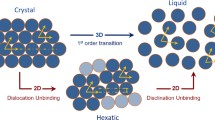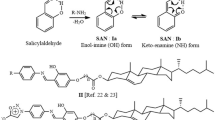Abstract
We studied the phase chirality in disklike lyotropic cholesteric (ChD) phases which were obtained by adding center and axial chiral dopants to achiral lyotropic nematic (ND) host phases. In a lyotropic nematic matrix of the ND phase in the hexadecyldimethylethyl-ammonium bromide/water/n-decanol ternary system, a ChD phase was induced by adding center chiral sterols (cholesterol, prednisolon, taurocholic acid) and the axial optically active compound R(−)-1,1′- binaphthalene-2,2′-diyl-hydrogen phosphate (BDP). The helical twisting power (HTP) of BDP is generally lower than the HTP of inducing substances with center chirality, such as cholesterol, prednisolon, etc. At constant composition of the ND phase, the helix lengths were determined from the ordered fingerprint texture, the so-called “spaghetti-like texture” seen in polarizing microscopy. The reciprocal helix lengths change linearly with the BDP concentration. The properties of the ChD phase (textures, helix lengths, micelle parameters) induced by the chiral compounds and changed by the composition of host phases give information on the mechanism of chirality transfer from the molecular level to that of the micellar aggregates and, eventually, to the liquid-crystalline superstructure. The structure in the ChD phase was described in the form of micelle parameters. For helix formation a minimum concentration of the chiral compounds is necessary. During the helix formation the number of micelles per helix length changes as a function of the concentration of the center and axial chiral molecules. The first step during the formation of the ChD phase is the solubilization of dopants into the micelles. Interaction between the optically active molecules then leads to the formation of hydrogen bridges between adjacent optically active molecules in the helical stack.
Similar content being viewed by others
Author information
Authors and Affiliations
Additional information
Received: 20 December 1999/Accepted: 22 May 2000
Rights and permissions
About this article
Cite this article
Dörfler, HD., Göpfert, A. Comparison of structures and properties of lyotropic cholesteric phases induced by center and axial chiral compounds. Colloid Polym Sci 278, 1085–1096 (2000). https://doi.org/10.1007/s003960000373
Issue Date:
DOI: https://doi.org/10.1007/s003960000373




